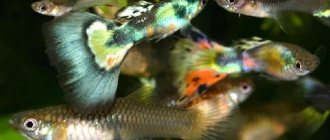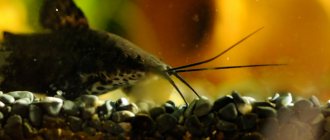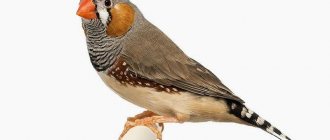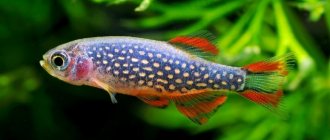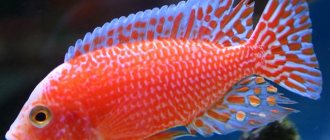Tarantula: description, structure, characteristics. What does a tarantula look like?
Tarantula belongs to the phylum of arthropods, class of arachnids, order of spiders, family of spiders -
wolves are the genus of tarantulas themselves. Like many arthropods, the body of the tarantula is covered with small hairs. In general, the tarantula’s body structure has two main parts: the cephalothorax and abdomen.
At the top of the tarantula's head there are as many as eight eyes, with 4 of them located in a straight line, and the remaining larger eyes located in a trapezoid. Thanks to this arrangement of the eyes, tarantulas have a viewing angle of 360 degrees. Also, in addition to well-developed vision, these spiders also have an excellent sense of smell, with which they can sense potential prey at a considerable distance (for these insects).
The size of the tarantula varies from 2.5 to 10 cm. The span of the legs of this spider can reach 30 cm. Like many insects in the world, female tarantulas are usually several times larger than males.
Throughout their lives, tarantulas change the peculiar chitinous “armor” that covers their body several times. The tarantula also has four pairs of long, hairy legs, allowing the spider to move comfortably across loose or even water surfaces.
The mandibles of the tarantula are covered with poisonous canals, they are very strong and serve the spider as a means of defense and attack.
The color of the tarantula is usually brown, gray or black. Although sometimes there are representatives of these spiders that have lighter colors.
Varieties
In total, more than 200 varieties of arthropods of this species can be found in nature. We will look at the most common types of tarantulas, where they are found, and what appearance is typical for them.
- Apulian . Its size is about 7 cm, males have a uniform color, while in females it is more varied and combined. The cephalothorax is combined, there is a light stripe, the abdomen is red in color, on which there are several stripes with a white-red border. They live in the mountains, where they create burrows up to 60 cm, and the entrance is always lined with leaves. This species of arthropod does not spin webs. During the day they sit inside the hole, where at night they can get food, or they leave the hole to hunt. Before cold weather, they seal the entrance to the house with dry grass and hibernate. After the onset of puberty, subject to natural habitat, females live no more than 5 years, males - a maximum of 3 years. The question of where they are widespread is difficult to answer. As a rule, these are Egypt, Italy, Libya, etc.
- Mizgir. Where it lives - in fields, gardens. Found in Russia and Ukraine. Dimensions – up to 35 cm, females are larger than males. The color depends on the color of the soil where the spider lives, so you can find dark brown, brown, or red specimens. There is a dark spot on the head. They dig themselves small holes up to 50 cm, where they line the holes with a special wall made of soil, grass, and plants. When molting begins, the spider closes the entrance to the hole with cobwebs or soil, the same thing happens in winter, when cold weather sets in. To catch prey, these spiders do not weave webs, but hunt small insects and climb into holes, where they guard their prey. Life expectancy is up to 5 years.
- Lycosa narbonensis . Quite large, their size can reach 6 cm. The color is black, the paws are long and covered with hairs. Where they live - most often it is Malta, Italy, Spain.
- Spanish tarantula . They feed on small invertebrates; spiders tend to feed on representatives of their own species. Where they live: in Europe and northern Africa.
- Brazilian tarantula . It has 8 eyes, the size excluding paws is up to 3 cm. They have a brown color, a stripe on the head, which smoothly turns into a light yellow color at the top of the back. Where the abdomen is located, the stripe turns into an arrow pointing forward. The abdomen is black. Paws are brown-red. They feed on cockroaches, crickets and small spiders. Where they live: in America, Argentina.
- Lycosa poliostoma . Common in meadows and gardens. During the day they hide in the steppes, in the meadows they create holes for themselves. They hunt at night. They feed on spiders and small insects. If you do not take into account the legs, the length of the arthropod is 3 cm. They are brown in color. There is a stripe on the head, the shade of which is lighter than the main color. They differ from the Brazilian tarantula in that their color is lighter, but there is also a stripe on the abdomen that smoothly turns into an arrow shape. The lower abdomen is black. A characteristic feature of representatives of this species is that females have shorter legs than males, but they are also larger, as is common in tarantulas. Where they live: America, Brazil.
- Lycosa leuckarti . Their color is gray-brown. The maximum length excluding the legs in females is about 1.2 cm, males are smaller - 0.9 cm. Where they live: Australia.
- Lycosa coelestis . On average, the length of individuals is 13 mm. They are brown in color, with 2 dark stripes on the back, which are located longitudinally. The abdomen is painted black. Where they live: in Japan
What is the difference between a tarantula and a tarantula?
Tarantulas are often confused with the tarantula spider, so to put an end to this, here are the differences between them:
Appearance
It is difficult for a non-specialist to determine from the photo and description what species this individual belongs to. For a specialist, in the absence of an object of known size in the photo (a matchbox, for example) and from an inconvenient angle, determining the type of spider is also not an easy task. All wolf spiders are similar to each other and differ in size and habitat. The most famous are the South Russian and Apulian tarantulas.
The easiest way for a non-specialist to distinguish between adult individuals is by size: the body length of the South Russian is 2.5-3 cm, the Apulian is 7 cm.
The color of tarantulas is reddish-gray. The body is covered with thick bristles. There are slight differences in color that make it possible to recognize the two species from a certain angle in a photo of a tarantula spider. The South Russian has a “skullcap” on his head - a small dark spot. But the spider must be photographed exactly from above so that this “cap” can be seen.
Adding to the confusion is the fact that in English, tarantulas are the name given to all large spiders that do not spin webs.
Spider tarantula
What do tarantulas eat?
As you probably already guessed, tarantulas are notorious predators, their food consists of numerous small insects and amphibians: caterpillars, mole crickets,
crickets, beetles, cockroaches, small frogs, etc. Tarantulas watch their prey from a hiding place and then quickly attack. Having attacked, they paralyze the prey with their poison, which subsequently turns its insides into a nutritious liquid, then the tarantula sucks it out like a “cocktail”.
The process of absorption of food by a tarantula can last several days, but in general they are not very voracious and can do without food for a long time, as long as they have access to water.
South Russian tarantula - Lycosa singoriensis
Photo of the South Russian tarantula
The South Russian tarantula has a body 2.5-3 cm long, densely covered with hairs. The spider is almost entirely black on the underside, and brownish-red on top. It can live in steppe, forest-steppe and desert zones. Distributed in Central Asia, Russia and Ukraine (covers the Crimean Peninsula). These tarantulas were also spotted in Belarus.
These spiders live in earthen burrows (30-40 cm). At night they go hunting. This tarantula is capable of jumping up to 20 cm in length. They feed on insects (crickets, grasshoppers, etc.). At the end of summer, spiders mate. The male actively moves his front legs and vibrates his abdomen, thus attracting the female.
After mating, the male must immediately leave, as the excited female may eat him. After some time, the female tarantula makes a cocoon from the web, where she lays her eggs. She attaches the cocoon to the top of her abdomen and reliably protects it. After the spiderlings are born (about 50 individuals), they climb back onto the spider and sit on it for some time.
The Latin name of the species is Lycosa singoriensis. The common name of the species is Mizgir. There is also the name “ground spider”, which Lycosa singoriensis received for its lifestyle. Prefers to live in dry climates.
Habitat areas:
- deserts;
- semi-deserts;
- steppes;
- forest-steppe (less often).
It is not found near large bodies of water, as it does not like wet soil.
Types of tarantulas, photos and names
There are about 200 species of tarantulas, but we will describe the most interesting of them.
Apulian tarantula
He is a real tarantula, lives in the south of Europe, including Italy (most likely it was he who gave the name to the entire species of these spiders) and also in North Africa. It is approximately 7 cm in length. Also, unlike other species of tarantula, it does not spin webs.
South Russian tarantula or Mizgir
As the name suggests, this tarantula lives in the south of Russia, Belarus, as well as our country Ukraine, in the countries of Central Asia. This species of tarantula is small, rarely exceeding 35 mm in size. A characteristic feature of this type of tarantula is the presence of a special dark cap. With the onset of cold weather, these tarantulas burrow deep into their burrows, where they successfully winter, and with the onset of spring they come to the surface.
Spanish tarantula
This tarantula also lives in southern Europe, particularly Spain, Italy, Portugal, and North Africa. It was once considered a subspecies of the Apulian tarantula, but was later classified as a separate species.
Brazilian tarantula
This type of dark brown tarantula lives in the tropical forests of South America, Brazil, Paraguay, and is found in many other South American countries. A characteristic feature of this tarantula is the presence on its head of a light longitudinal stripe of a yellowish tint.
Where does the tarantula spider live?
Photo: Tarantula spider from the Red Book
The habitats of the species are represented by a wide range - the southern part of Eurasia, North Africa, Australia, Central and Asia Minor, America. Representatives of the genus can be found in Russia, Portugal, Italy, Ukraine, Spain, Austria, Mongolia, Romania, and Greece. Arthropods choose arid areas to live.
They live mainly in:
- deserts;
- steppes;
- semi-deserts;
- forest-steppes;
- gardens;
- vegetable gardens;
- on the fields;
- meadows;
- along the banks of rivers.
Tarantulas are heat-loving arachnids, so they cannot be found in cold northern latitudes. Individuals are not particularly picky about their habitats, so they even live in saline steppes. Some manage to get into houses. Distributed in Turkmenistan, the Caucasus, Southwestern Siberia, and Crimea.
Most predatory spiders prefer to live in burrows that they dig themselves. They choose the location for their future home very carefully. The depth of vertical burrows can reach 60 centimeters. They move the pebbles to the side and rake out the soil with their paws. The walls of the tarantula's shelter are covered with cobwebs. It vibrates and allows you to assess the situation outside.
At the end of autumn, spiders prepare for wintering and deepen their homes to a depth of 1 meter. The entrance to the hole is plugged with leaves and branches. In the spring, animals crawl out of the house and drag the web behind them. If it suddenly breaks, there is a high probability that the animal will no longer find its shelter and will have to dig a new hole.
Now you know where the tarantula spider lives. Let's see what the poisonous spider eats.
Reproduction of tarantulas
The mating season for many species of tarantulas occurs in late summer. A sexually mature male weaves a web, then begins to rub his abdomen against it. As a result of this, he ejaculates seminal fluid, which ends up on the web. The male then plunges his pedipalps into it, which absorb it and become ready for fertilization.
And only then does the search for the female begin. Having found his “lady,” the male begins courtship, which includes performing a kind of courtship dance. If the female reciprocates the “gentleman’s feelings,” he plunges his pedipalps into her cloaca and fertilizes her. Then it is very advisable for the male to quickly leave his “lady” so as not to become dinner for her, as happens with
Praying mantis of some other insects.
Then the baton of prolongation of the genus passes to the female, she begins to weave a special cocoon where she lays her eggs; there are usually from 50 to 2000 eggs per clutch.
The eggs mature within 40-50 days, and small tarantulas hatch from them, which begin to grow rapidly, and by 2-3 years have already reached sexual maturity.
Structure
Externally, tarantulas are not fundamentally different from other spiders. But their internal structure is more primitive than that of the “higher” species.
The tarantula's cephalothorax is “empty” inside; all internal organs are located in the abdomen. There are 8 eyes on the front of the cephalothorax. The distribution of the organs of vision is uneven:
- bottom row 4 small eyes;
- medium – 2 large;
- top – 2 small ones.
The latter are located on the sides of the cephalothorax, allowing Lycosa representatives to see around 360°. The tarantula's vision is very well developed, as this spider hunts at night.
There are 5 pairs of limbs on the cephalothorax. The first pair of limbs has transformed into powerful chelicerae, with which the tarantula bites through the shell of its prey. The second pair, pedipalps, helps to grasp and hold prey. In the male it is also a reproductive organ, which is why his pedipalps are more developed than those of the female. The remaining 3 pairs are for movement.
These three pairs contain thin sensory hairs that serve as tactile and auditory organs. Thanks to the hairs, the spider hears the approach of danger or prey. This is where the similarities between different species of tarantulas of the genus Lycosa end. Due to different living conditions and climates, the lifestyle and breeding times of these spiders do not coincide.
Tarantula bite and the effect of poison on humans. Is the tarantula dangerous?
The tarantula itself is unlikely to attack a person. But he can be forced to do this by the actions of the person himself, for example, if he accidentally touches a spider, the latter may bite in self-defense.
A tarantula bite is not dangerous for a healthy person, with the exception of children and people with allergic reactions, in such cases it is imperative to seek professional medical help.
Symptoms of a tarantula bite and their consequences may look like this:
- local pain at the site of the bite, redness and swelling.
- drowsiness, lethargy, general poor health.
- a sharp but short-term increase in temperature.
- in some cases there may be nausea and vomiting.
Virulence
The powerful chelicerae of tarantulas look intimidating due to the fact that the spider needs to pierce the hard shells of beetles with them. The poison is designed for small insects. Therefore, Lycosa singoriensis easily pierces human skin, but cannot cause serious harm. The consequences of an attack by a South Russian tarantula feel similar to a bee or wasp sting:
- sharp pain at the time of the bite;
- local swelling;
- nagging pain at the site of the spider bite.
Sometimes the skin turns yellow. Yellowness lasts about 2 months.
Homemade tarantula - care and maintenance. What to feed a tarantula at home?
Recently, some exotic pet lovers have been getting pet tarantulas. And why not, because they are quite easy to keep and can live in an aquarium or terrarium. At the bottom of the container it is necessary to pour a substrate consisting of a mixture of sand, clay and earth. Also, the tarantula terrarium should be equipped with an automatic drinker with fresh water and a shallow pool.
The optimal temperature for keeping these spiders should be 25-27 C. You can feed tarantulas with small pieces of fresh beef, as well as live cockroaches and frogs, if, of course, you can catch them. But fortunately, you don’t need to feed them often, so for an adult healthy tarantula it will be normal to eat once a week.
It is also important to remember that only one tarantula can be kept in a terrarium; if there are two of them, then as a result of constant skirmishes only one, the strongest, will survive.
Lifestyle
In the warm season, adults are busy searching for a mate. In males, the instinct of self-preservation is dulled, so they can be seen even during the day. When it finds a female, it taps its legs on the ground, vibrates its abdomen and quickly moves its limbs, announcing its presence.
We suggest you read: How to get rid of large spiders in the house. Getting rid of spiders in the country house and garden with your own hands
If she accepts advances, she repeats his movements. Everything else happens at lightning speed. After transferring the sperm, the male runs away so as not to be eaten by the female, since during this period she needs protein. Then the female falls asleep in her burrow until spring.
In the spring, it will come to the surface to expose its abdomen to the sun's rays, then lay eggs (300-400 pieces) in a woven web. Then he puts it into a cocoon and carries it on himself.
As soon as the babies show signs of life, the mother will gnaw through the cocoon and help the spiderlings come out. The babies will be placed on their mother's body in multiple layers until they become independent. Then the mother will resettle the young people, gradually throwing them off of her.
The lifespan of Lycosa varies greatly and depends on two factors:
- frequency of molting: the more often a spider molts, the less it lives;
- the possibility of falling into seasonal hibernation.
In nature, Lycosa singoriensis lives for approximately 2 years. In captivity, he does not have the opportunity to hibernate and stop developing for a while. Because of this, the life expectancy of the arthropod is reduced to 1 year. A too-fed life also shortens the life of a spider in an apartment. The more an arthropod eats, the faster it grows and is forced to molt. Shedding takes too much vitality. You can avoid very frequent changes of skin if you keep the animal from hand to mouth.
Since Lycosa are nocturnal animals, studying their habits is difficult. Lycosa singoriensis dig vertical burrows and weave them with webs, pursuing 2 goals:
- protecting walls from crumbling;
- creation of an alarm system.
Thanks to the web on the walls of the hole and the network that is spread around the hole, the South Russian tarantula hears the approach of both danger and prey in advance.
For the winter, before hibernating, the South Russian tarantula deepens its burrow and closes the entrance to it. It may not hibernate if placed in a warm room.
Bites
Usually the tarantula does not attack people on its own. An attack can be forced by the actions of the person himself, who comes close to the mink or accidentally touches the spider. Fortunately, a venomous tarantula bite is not dangerous to a healthy adult. The exceptions are children and people with a predisposition to allergic reactions.
Tarantula is in an attacking pose
Symptoms and consequences of a tarantula bite can be expressed as follows:
- local pain and redness of the skin, as well as swelling;
- drowsiness and general malaise;
- a sharp short-term increase in general body temperature;
- in exceptional cases, nausea, vomiting and difficulty breathing may occur.
We suggest you read: What do house spiders eat in winter?: useless_faq
What to do if you are bitten by a tarantula to minimize the consequences?
First aid for a tarantula bite:
- wash the wound with antibacterial soap;
- treat it with an antiseptic;
- call for medical help;
- Cool the tarantula bite area with an ice pack;
- take antihistamines;
- Give the bitten person a large amount of fluid to help remove toxins quickly.
Here we will reveal the secret of whether the tarantula is dangerous for humans. There is no doubt that a spider bites painfully; in any case, those who were bitten noted that it was similar to being stung by a bee.
One of the effective ways of what to do if you are bitten by a tarantula is to use the antidote contained directly in the spider’s body. It is enough to crush the animal and lubricate the bite site with juices, then the pain will decrease and the wound will heal faster.
To the question of whether the tarantula is poisonous or not, we will also answer in the affirmative, otherwise how would it kill its victims. However, its venom is not dangerous for humans unless there is an individual intolerance or allergy to bites.
A tarantula bite is not fatal to humans. The symptoms resemble a wasp sting. First aid consists of washing the bite site with soap and water, drinking plenty of fluids, and immediately contacting a doctor. If you catch it, smear the bite site with its own blood (the spider's blood contains an antidote) - this recipe is more suitable for travelers and tourists.
In most cases, symptoms begin to appear quite quickly and first aid should also be prompt, but thoughtful.
- The first thing to do is wash the wound with soapy water.
- The next action should be aimed at preventing the spread of the poison. This is achieved in two ways: immobilize the affected limb with a splint and apply a tight bandage above the bite site, thereby reducing blood circulation.
- It is worth applying a cold compress to the wound itself, which will also delay the action and spread of the poison.
- Drinking more will also be a reducing factor. It will also help remove poison from the body.
- In order to relieve painful symptoms, you can give the victim an aspirin tablet.
Having done all this, there is no need to calm down. It is imperative to take the victim to a doctor, even if he is a few kilometers away. The clinic will provide more qualified assistance and will be able to take emergency measures in case of complications.
Of course, you can add some more aspects, covering the question: are there poisonous spiders in Russia and what to do if you encounter them. But this information will be for specialists. Ordinary people need to remember that under no circumstances should they play and have fun with spiders. But you shouldn’t just destroy them either.
Nutrition
All insects and animals that are smaller than the tarantula are at risk of being eaten. They do not stray far from their burrow to hunt. They draw in their victim and are already having their meal at home. This happens somewhat unusually for them.
Spiders do not have teeth, so when they approach their victim, they pierce a hole in it, through which they inject their special agent to dissolve all the insides of the victim. And after that they suck out the dissolved contents without any problems.
Spiders of central Russia
Arthropods live here, their habitat extending from Central Europe to Murmansk. The most common spiders in central Russia are Heiracanthium and Silverwort.
Heiracanthium is found in the Moscow region, Southern Siberia and the Volga region. This is a rather poisonous species that lives far from human habitations, and therefore cases of its bites are rare.
Its body is covered with a special secretion, which, when immersed under water, allows it to retain air on the animal’s body. Because of the air gap, the diving spider appears silver. The arthropod feeds on fish fry.
Thus, spiders quite easily adapt to any living conditions, and therefore they can be found everywhere throughout Russia.
The most dangerous species in Russia is the karakurt. Spider bites rarely cause death, but they are dangerous not only because of the toxicity of the venom, but also because of a possible allergic reaction. This is why a bite from even a harmless and non-toxic spider can have serious consequences.
Some interesting facts about the Goliath tarantula
- In the habitats of these largest spiders, many residents eat them as food, not only mature individuals, but also their eggs. As a result, the population of these animals in nature is gradually decreasing.
- The goliath spider can survive without food for about 6 months.
- The most difficult period in the life of this animal is molting. The goliath tarantula moves little at this time and does not eat anything.
- The web of these spiders does not serve as a trap for their prey, like other representatives of the species. Tarantulas are real hunters; they themselves track down their prey and attack it.
- There are cases - after mating, the female eats her partner.
History of the name
There is a species of spider common in the area around the city of Taranto (or Tarantum to the Renaissance people) which during the 15th century was attributed to the cause of a strange disease called Tarantism (Gertsch 1979). According to legend, the bite of such spiders led to illness, and anyone bitten was doomed to death, and the only cure was considered a special dance - the tarantella. Now, several centuries later, opinions are expressed that the tarantella was a simple excuse for some closed feasts, which the authorities of that time could condemn.
From interesting facts
When preparing an essay on the topic “Tarantula Spiders,” you should indicate that they are unique creatures. Having large sizes and causing real horror, they are quite peaceful. When in captivity and under normal conditions, spiders can live up to 20 years, while females are longer-livers than males.
Large representatives are about 30 cm in volume, which is equivalent to a dinner plate. Excessive aggression is attributed to these peace-loving arachnids by horror film directors. In fact, they rarely bite humans and are quite docile. And the animal does not produce enough poison to kill a person; it would rather retreat than attack a dangerous and very large object.
In a report on tarantulas, it is important to point out that they are easily wounded and have very thin skin on their abdomen. When falling from a height, they often die, so picking them up is not recommended. The web is made of high-quality silk. Females line their burrows with it and strengthen their walls. Males weave peculiar nests for laying eggs and build cunning traps at the entrance to the home.
The tarantula grows throughout its life and is capable of changing its exoskeleton several times. This feature makes it possible to restore limbs damaged during life. The paw will certainly grow back during the next molt. If its size is not within the required limit, repeating the update process will fix everything.
Are there tarantulas in Russia?
These spiders live almost all over the world. To live they need the following conditions:
- warm;
- arid climate;
- steppe or semi-steppe terrain;
- relatively soft soil.
Some territory of our country meets these criteria, which is why tarantulas exist in Russia. However, they are common in a small part of it.
Only the southern Russian species of tarantula lives in Russia. This is a small spider, up to 30 mm. Quite inconspicuous, has a gray color and easily hides in the grass in a vacant lot. It can live in fields, forest edges and even vegetable gardens. Individuals live in shallow vertical burrows and hunt mainly at night, so it is unlikely to step on it during the day. You can find a tarantula while cultivating a garden or field.
The South Russian species has characteristic features: relatively thick fluffy paws, two large eyes and several small ones. It is significantly different from most spiders living in Russia, so it will not be difficult to recognize it, and, therefore, avoid it.
All spiders are poisonous, and South Russian ones are no exception. However, you should not be afraid of this spider, since it cannot cause much harm to a person.
This spider needs venom glands to cope with its prey. He attacks her, injects poison with the help of chelicerae and waits for the victim’s insides to turn into a nutrient medium. But the concentration of toxins and the activity of the poison are low, and can only cope with a small victim.
It is worth noting that spiders do not attack people first, since this is too big a sacrifice for them. An attack can only occur as a defense. Therefore, if you do not want to be a victim of a tarantula, behave carefully in steppe areas so as not to accidentally crush the spider.
Since these spiders need an arid and warm climate, for their existence they choose steppe terrain, mainly the south of Siberia; a large number of them have also been observed near water.
In Russia, single individuals or colonies have been spotted in Kursk, Saratov, Astrakhan, Tambov, Orel, Lipetsk and even Belgorod.
By nature, spiders do not migrate. They are active in the warm season and hibernate in the winter. However, in the last few years, an expansion of the range of these spiders has been noticed. This is due to general climate change, in particular warming. So, this type of spider was seen in more western and northern areas.
These insects live in the steppes, sometimes making their homes in people's gardens or courtyards. They rarely crawl into the house; this can happen due to the search for water, so most often in a private house they can be seen in or near the sink. They don't crawl into apartments.


